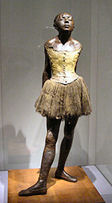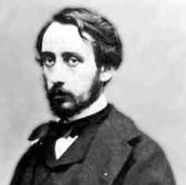 Composer and pianist, Denis
Levaillant
was born in Paris in 1952. His music comprises works in a wide
variety of forms including opera, ballet, orchestral, choral,
chamber and electro-acoustic music and material for radio and
film. He began studying the piano at the age of six, and recorded
Ravel’s Valses nobles et sentimentales when he was 12.
He is reported to be fascinated by dance, jazz, improvisation
and the circus. He holds a Master’s degree in Philosophy.
Composer and pianist, Denis
Levaillant
was born in Paris in 1952. His music comprises works in a wide
variety of forms including opera, ballet, orchestral, choral,
chamber and electro-acoustic music and material for radio and
film. He began studying the piano at the age of six, and recorded
Ravel’s Valses nobles et sentimentales when he was 12.
He is reported to be fascinated by dance, jazz, improvisation
and the circus. He holds a Master’s degree in Philosophy.
When the choreographer
of La Petit Danseuse de Degas heard Denis Levaillant’s
Piano Concerto, he was so impressed that he not only contracted
Levaillant to write the music for his ballet but also used the
music of the Concerto’s Andante in the ballet.
Edgar Degas’ La Petite Danseuse de Quatorze
Ans
Edgar Degas’s sculpted
La Petite
Danseuse de Quatorze Ans" ("Little Dancer of Fourteen
Years of age") circa. 1881.
It is a sculpture
of a dance student called Marie
van Goethem. Unusually for its time, the sculpture
was made in wax and dressed in a cotton skirt with a hair ribbon.
It stands on a wooden base. Later, in 1922, 27 bronze casts
were made. When La Petite Danseuse de Quatorze Ans was
shown at Paris’s Sixth Impressionist Exhibition in 1881, it
caused immediate controversy. Many critics were shocked. It
was thought to be ugly; some felt it looked like a medical specimen
partly because it was exhibited in a glass case. Some considered
it grotesque and primitive. The sculpture can be seen today
in the Quai d’Orsay Museum,
Paris.
 The relationship
between Marie van Goethem and Edgar
Degas
(pictured right) is contentious but it was not unheard
of, in the 1880s for young artists of the Paris Opera to seek
the protection of their stage-door admirers. Marie van Goethem
grew up with her two sisters in a deprived suburb of Paris.
When their father died, their mother made ends meet by enrolling
her daughters at the Opera’s ballet school and hiring them out
as artists’ models in their studios. But this business collapsed
when the girls, encouraged by their mother, drifted into the
world of petty crime and prostitution.
The relationship
between Marie van Goethem and Edgar
Degas
(pictured right) is contentious but it was not unheard
of, in the 1880s for young artists of the Paris Opera to seek
the protection of their stage-door admirers. Marie van Goethem
grew up with her two sisters in a deprived suburb of Paris.
When their father died, their mother made ends meet by enrolling
her daughters at the Opera’s ballet school and hiring them out
as artists’ models in their studios. But this business collapsed
when the girls, encouraged by their mother, drifted into the
world of petty crime and prostitution.
This sculpture,
the story of Marie van Goethem and the art of Edgar Degas have
all inspired this ballet. [In the story of the Ballet, the little
dancer represents all three daughters.]
La Petite Danseuse de Degas – The Ballet review.
The story is set
around the dreams and aspirations of the little dancer whose
ambition is to become an étoile (principal ballerina). But her
more realistic, more down-to-earth mother knows they could never
afford such long and intensive training and is set upon exploiting
her daughter. Inevitably the little dancer is compromised and,
at length, is caught stealing a rich ballet fan’s money, and
subsequently dismissed from the Opèra, imprisoned, then put
to work in the sweat shop that is the Laundry, her dreams shattered.
Put simply, this
imginative ballet is stunning. The costumes throughought all
the varied scenes and locations (streets, dance class, artist’s
studio, Opera ball, cabaret, prison and laundry) are all exquisite.
Just one example: in the ballet class the dancers’ white dresses
have beautifully harmonised pastel-coloured sashes and underskirts;
and the dancers’ groupings and attitudes in repose are so aptly
and beautifully lit that their resemblance to Degas’s paintings
is quite uncanny. Ezio Toffolutti’s sets are simple but effective
and again they not only enhance the feeling of clever emulations
of Degas’s artwork but also reflect the reality that is, for
instance, the Opèra’s ballet schoolroom.
The sense of the
reality of the dancers’ life behind the little dancer’s dream
world is evident in so many ways and is a tribute to Patrice
Bart and his team’s research and imagination. At the beginning
of the dancing class scene, for instance, we see a male junior
dancer with his water jug preparing the dancing area for the
little girls’ practice – this sequence is daintily choreographed,
the girls’ dancing being full of charm and innocence. We also
note that the musician attending the student dancers is a violinist
not a pianist; this is historically accurate.
Bart’s choreography
and the dancing of all the leads and the corps de ballet is
consistently top drawer. La Petite Danseuse de Degas
is very much an ensemble ballet. Clairmarie Osta as the petite
danceuse is central and she so touchingly conveys, in Bart’s
adroitly conceived dances, the 14-year old’s vulnerability,
her starry-eyed ambitions grounded by her naiveté, her unwittingly
comic posturing and ultimately her desolation. She is supported
by a wonderful cast. All shine: Dorothée Gilbert is sublimely
graceful as the fairy godmother-like étoile. She is strongly
partnered by Mathieu Ganio as the dancing master – one of the
highlights of the production is the pas de trois dance
between these two and la petite danseuse during the latter’s
dream sequence. José Martinez as the subscription holder to
whose seduction la petite is forced by her mother - tellingly
portrayed by Elisabeth Maurin cast in a wicked step-mother-like
portrayal to extend the fairy tale imagery - is lofty and aloof.
The Man in Black who can be interpreted as Degas and the little
girl’s Destiny is a shadowy puppetmaster figure.
Denis Levaillant’s
interesting mix of tonal and atonal music - sometimes gleaming,
diamond-hard and often favouring batteries of percussion, particularly
xylophone and tubular bells - spans many styles from the baroque
to modernism and jazy figures via Late Romanticism and Impressionism.
An inspired and
visually ravishing creation. This ballet deserves to go from
success to success.
Ian Lace
Degas resource page

